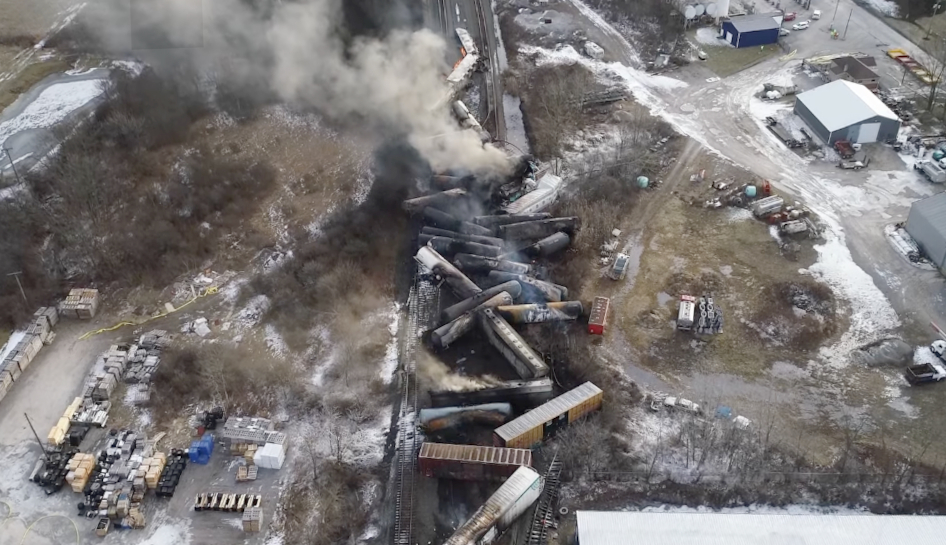Aerial view of the train derailment wreckage in East Palestine, Ohio, Feb. 5, 2023. (NTSB photo).
Norfolk Southern and its contractors erred when they made the call to release and burn toxic chemicals leaking from rail cars following the 2023 derailment of a train in East Palestine, Ohio, the National Transportation Safety Board said during a Tuesday hearing.
Five of the rail cars had been heated by a fire caused by the derailment, but the railroad failed to detect that the cars’ temperatures had started to drop, making the release unnecessary because the danger of explosion was receding, NTSB investigator Paul Stancil said Tuesday.
In addition, trackside detectors failed to detect how hot the temperature of a wheel bearing on the train had become 20 miles before the derailment occurred, according to the NTSB.
“On behalf of the entire agency, I want to recognize the significant impact that this derailment has had on the community in East Palestine, Ohio, in Darlington, Pennsylvania, and all the surrounding areas throughout the state of Ohio, throughout the state of Pennsylvania,” NTSB Chair Jennifer Homendy said Tuesday.
The agency was presenting its final report on the Feb. 3, 2023 derailment that left residents of the region with health issues and pollution concerns that they say have yet to be fully addressed. The NTSB presented the findings of its 17-month investigation to a full house in East Palestine High School’s auditorium.
“Unfortunately, some have sought to minimize the wide-ranging impacts of this derailment, pointing to the fact that there were no fatalities or injuries, and for this, we are certainly grateful,” Homendy said. “But the absence of a fatality or injury doesn’t mean the presence of safety.”
On Feb. 3, 2023 at about 9:30 p.m., a Norfolk Southern train with about a dozen cars carrying vinyl chloride derailed near the Ohio-Pennsylvania border
In the days that followed, local emergency officials vented and burned vinyl chloride, creating a black cloud of smoke over the surrounding area that could be seen for miles away. As vinyl chloride burns, it breaks down into carbon monoxide and hydrogen chloride. Mixed with water, hydrogen chloride makes hydrochloric acid, which is toxic to fish. Officials estimated 3,500 fish in nearby waterways were killed in the days following the venting. Burning vinyl chloride also creates a small amount of phosgene gas, a chemical weapon used during World War I.
But Norfolk Southern did not inform local first responders about information it had received from OxyVinyl, the manufacturer of the chemicals, whose on-site team had inspected the train cars and found that the risk of explosion was low and the cars were cooling, NTSB investigators found.
“Norfolk Southern and its contractors continued to assert the necessity of a vent-and-burn, even though available evidence should have led them to re-evaluate their initial conclusion,” Stancil said.
As a result, the first responders, including local firefighters, remained at the derailment scene longer than they should have, exposing them to “post-derailment hazards,” NTSB investigator Troy Lloyd said. This meant decision makers at the scene did not have complete information when they agreed to the railroad’s recommendation to vent the chemicals.
After the conclusion of testimony on Tuesday, the NTSB will vote on final findings and make recommendations. The NTSB does not have enforcement authority, but has a team that follows up on recommendations to ensure action is being taken by the proper authorities.
During Tuesday’s hearing, investigators also said the use of a type of rail car to transport butyl acrylate, a flammable chemical that caused the fire the evening of the derailment, also contributed to the aftermath of the derailment. The design of the cars, according to the Pipeline and Hazardous Materials Safety Administration, have “a lower ability to survive derailments and fires without releasing its contents compared to current tank car designs.”
DOT 111 tank cars are being phased out of carrying flammable materials as of 2029, although the Rail Safety Act of 2023 would move that date up to 2025.
“The events that eventually led to the vent and burn could’ve been avoided had there been no DOT 111 tank cars carrying combustible and flammable liquids on this train,” Stancil said.
“There is no finish line when it comes to improving safety,” John Fleps, Chief Safety Officer at Norfolk Southern said in a statement June 21 describing its new vent and burn workgroup. “While rail remains the safest way to transport goods over land, as a learning organization we will continue looking for improvements in all that we do.”
The railroad agreed to pay $310 million in a settlement with the federal government, to pay for violations of the Clean Water act and the costs of the U.S. Environmental Protection Agency’s cleanup efforts at the scene. In April, Norfolk Southern agreed to a $600 million settlement of a class action suit with residents and businesses.
The company did not admit to any liability, wrongdoing or fault in the settlement, which would end all class action claims related to the derailment from residents within a 20-mile radius of the derailment site near the Ohio-Pennsylvania border. For those who choose to participate, the company said in a statement the settlement would also cover personal injury claims within a 10-mile radius of the derailment.
In a report released June 19, environmental researchers said the chemicals released in the aftermath of the derailment affected 16 states, precipitation and pollution data showed.
This developing story will be updated.
The post NTSB: Norfolk Southern controlled burn of toxic chemicals in E. Palestine derailment unnecessary appeared first on Pennsylvania Capital-Star.

